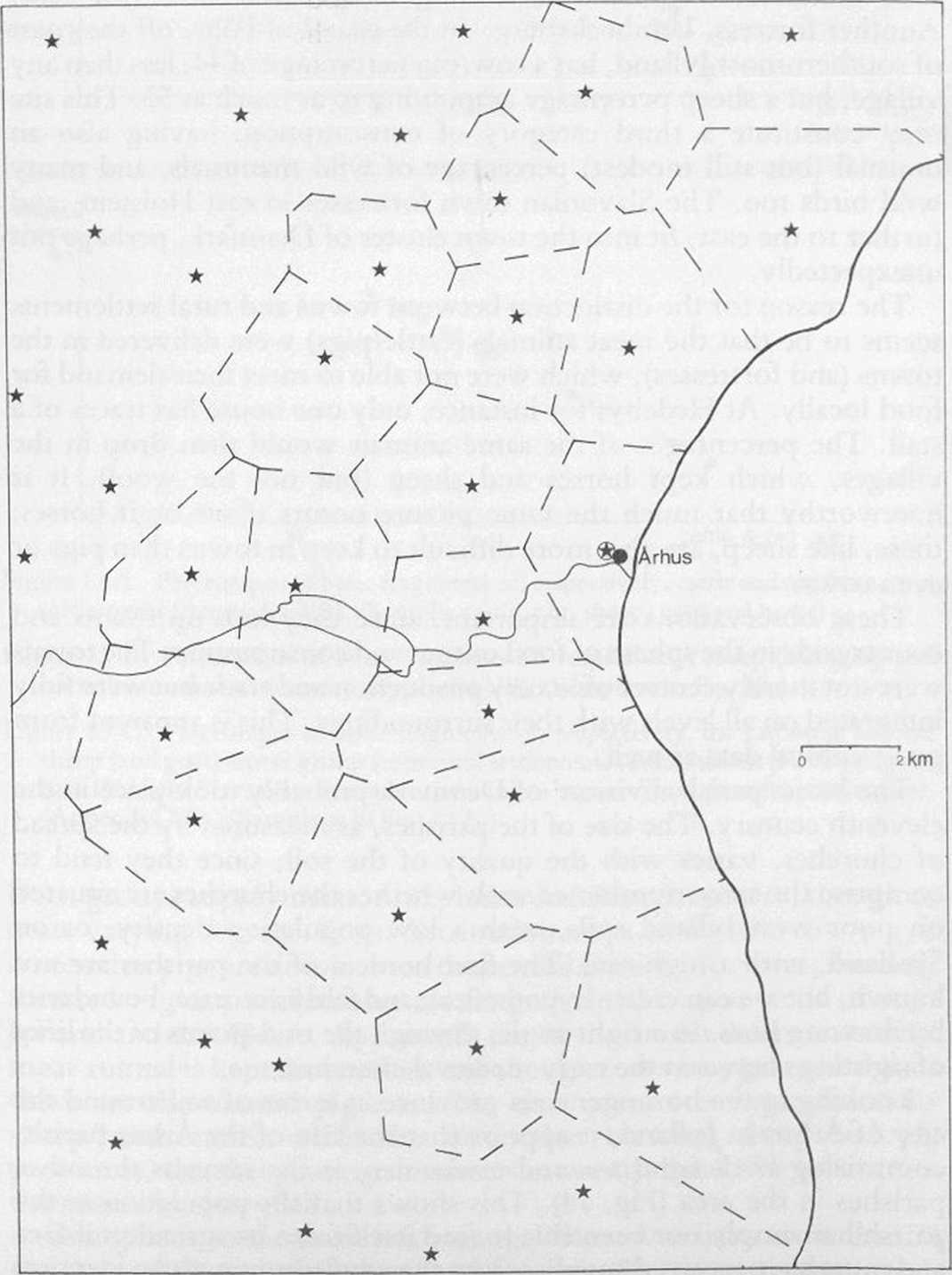32 (433)
58 The Viking Age in Denmark
and from a rurąl scttlemcnt, Elisenhof, less than fifty kilometres to the west, on the coast, have further exemplified thcse findings.23 It is seen, for instance, that the fleshy parts of the limbs of cattle especially, and to some degree of pigs, are under-represented at Elisenhof, if we apply the minimum numbers of individuals (as estimated from the number

Figurc 14 The spread of early medieval churches in the vicinity of Arhus (Jylland) with hypothetical ‘parish-borders’
ofjaws). At Hedcby the same bones are over-reprcsented, as a rcsult apparcntly of the import of meat from the rural settlements. The lack ofjaws at Hedeby indicates that the killing of the animals took place away from the town. If we look, in the same way, at an early Iron Age settlement at Feddcrsen Wierdc on the Weser estuary, sonie 70 kilometres to the south of Elisenhof, there is no imbalance between the number ofjaws and other bones. In this period only smali amounts of foodstuffs would be meant for use outside the villages, the units of production; this lack of surplus, incidentally, madę the societies morę vulnerable to crises. Consequently the early Iron Age settlements cover also the ‘town-range’ of the above percentages of cattle and pig bones versus fragments of sheep/goat and horses (Appendix VII E). The cattlc/pig percentage varies between about 50 to over 80. Indeed with a sufficient number of samples from the centuries between, say, the beginning and end of the first millennium A.D. the coming of towns could be precisely detected on the basis of the meat con-sumption alone, or, by the onset of ccreal-agriculture, directed at feeding larger populations, including towns.
Finally, if we study the sex-ratios and the ages of slaughter of the Viking Age animals, we notę that the cattle have varying killing ages, the adults being mainly cows (for the sake of the milk and the reproduction). Pigs are often killcd young, though at Hedcby many appear to have been kept till they were old.24 The same distinction is noted for the Hedeby sheep (the old animals being kept for the wool). In Arhus and Lund the majority of both pigs and sheep were young, and mostly małe.25
It is probably too early to comment on these differences, but it is worth remembering that Hedeby had the largest and ethnically most diverse concentration of population in Scandinavia. Furthermore, it was apparcntly also the most complex and stratified society. This may mean that Hedeby saw greater differences in the access to meat of high quality than the other cities and towns.
D. Rural settlements
The settlement system that formed the basis of Viking Age subsistence is difficult to grasp. We lack a coherent geographical picture, and we have only a modest knowledge of the single sites, except, perhaps, from a few recent excavations.
To judge from the size and plan of the major houses, the basie subsistence units in the early Iron Age were the family and the group of farnilies inhabiting the villagcs that archaeologists have revealcd. The integration on a higher level is morę difficult to establish but must have been in existence, sińce the sites vary, even in the same province, with respect to type and quality of land, for instancc, and
Wyszukiwarka
Podobne podstrony:
58 (195) 110 The Viking Age in Denmark Platę VI. Sample from late tenth-century silver-hoard at Taru
66 (160) 126 The Viking Age in Denmark have becn fouhd (Figs 32-3).7 They stem from thc same provinc
57 (213) 108 The Viking Age in Denmark Platę IV. Silvcr and copper dccorated spurs, length about 21
60 (189) 114 The Viking Age in Denmark Platc X. Ship-sctting and runestonc (on smali mound) at Glave
62 (179) 118 The Viking Age in Denmark Plato XIV. Iron tools from a tenth-ccntury hoard atTjclc, nor
63 (170) 120 The Viking Age in Denmark % Platę XVI Pagc with illustration of an English manuscript f
64 (171) 122 The Viking Age in Denmark Figurc 30 Distribution of wealth in three cemeteries as measu
68 (153) 130 The Viking Age in Denmark two tortoise bucklcs to reprcsent wornen of high standing, th
69 (151) 132 The Viking Age in Denmark heavy cavalry burials, fincr wcapon graves of thc simple type
70 (150) 134 The Viking Age in Denmark cemetcry at Lejre on Sjaelland a dccapitatcd and ticd man was
74 (134) 142 The Viking Age in Denmark 5C~ł silver 800 900 kxx) A.D. Figurę 37 Fluctuations in che r
75 (129) 144 The Viking Age in Denmark Figurę 38 Average weight ofthesilver-hoardsofthe period 900 t
27 (504) 48 The Viking Age in Denmark Europcan meteorological data for earlier per
29 (466) 52 The Viking Age in Denmark We have already mentioned the expansion of grasses, and it is
30 (454) 54 The Viking Age in Denmark touch, so the political developmcnt we have described in previ
31 (444) 56 The Viking Age in Denmark pig SO- A horse B 50- 50 cattle 50" sheep (Qoat) Figurę 1
78 (124) 150 The Viking Age in Denmark Figuro 41 Danish coins, c. 800 to 1035 A.D. (1) = ‘Hcdeby’ co
79 (124) 152 The Viking Age in Denmark Roskilde, in the newly won provinces, were the most important
80 (129) 154 The Viking Age in Denmark Figurc 44 Distribution of Arabie coins in a sam ple of north-
więcej podobnych podstron